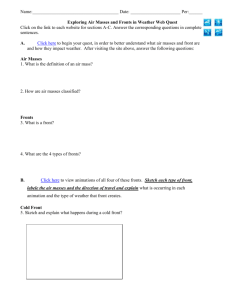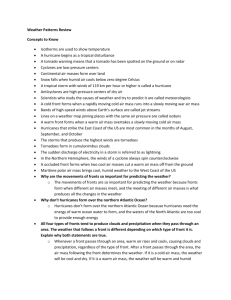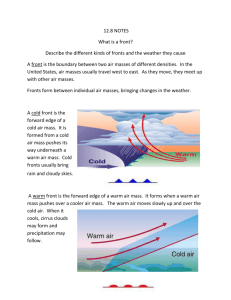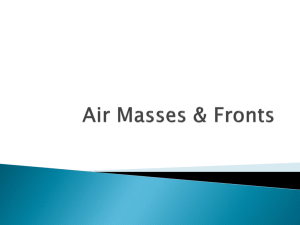17.1 – Air Masses and Fronts body of air that has
advertisement
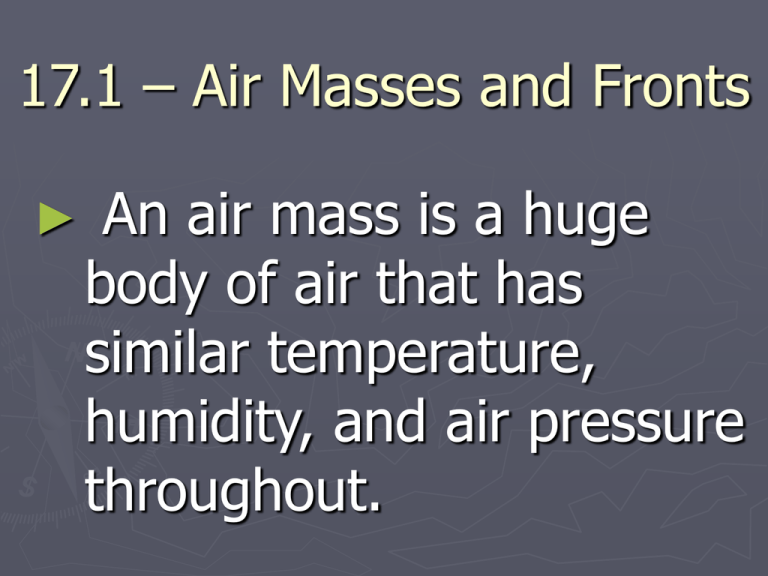
17.1 – Air Masses and Fronts ► An air mass is a huge body of air that has similar temperature, humidity, and air pressure throughout. Types of Air Masses Scientists classify air masses according to temperature and humidity. ► There are four major types of air masses that influence weather in N. America. ► 1. Maritime Tropical – ► Warm, humid air masses that form over the oceans and Gulf of Mexico ► They travel up from the south bringing warm, humid air. ►Bring showers and thunderstorms in the summer. ► Bring snow in the winter. 2. Maritime Polar Cool, humid air masses that form over the North Pacific and Atlantic Oceans. ► They affect the West Coast more than the East Coast. ► They bring rain, and cool temps to the west coast. ► 3. Continental Tropical Hot, dry air masses that form only in summer over areas in the SW U.S. and N. Mexico. ► They move NE, bringing hot dry weather. ► 4. Continental Polar Large air masses that form over N. Canada and Alaska. ► Bring cool, dry air to much of North America. ► FRONTS As huge masses of air move across land and water, they bump into each other. ► ►When 2 masses with different temps and density collide, they do not mix. ► The area where the air masses meet and do not mix becomes a “front” A front forms because one air mass is less dense than the other air mass. ► There are 4 types of fronts: cold fronts, warm fronts, stationary fronts, and occluded fronts. ► Cold Fronts Cold fronts form when a rapidly moving cold air mass runs into a slowly moving warm air mass. ► Often results in the formation of clouds, rain, and/or snow. ► Also, thunderstorms. ► Warm Fronts Forms when a rapidly moving warm air mass collides with a cold air mass. ► Can cause rain or fog. ► Slower moving than cold front. ► Stationary Fronts Forms when a warm air mass and a cold air mass meet and no movement occurs. ► Neither air mass has enough force to move the other. ► Occluded Front Forms when a warm air mass is caught between two cooler air masses. ► The warm air mass gets lifted and cut off from the ground by the two cooler air masses. ► 17.2 - Storms ► A swirling center of low air pressure is called a cyclone. ► As warm air at the center of the cyclone rises, cooler air blows toward this from areas with higher pressure. ► The winds swirl in a counter- clockwise fashion b/c of the Coriolis Effect. ► Cyclones and low pressure areas are associated with storms and precipitation. Anticyclones are the opposite of cyclones. ► They are areas of high pressure that are associated with dry and clear weather. ► Air blows from high pressure areas to low pressure areas. ► Kinds of Storms A storm is a violent disturbance in the atmosphere. ► Storms involve sudden changes in air pressure, which cause rapid air movements. ► Hurricanes A hurricane is a tropical storm that has winds of 74mph or greater. ► They begin over warm water as a low pressure area. ► The center of a hurricane is a ring of clouds surrounding a quiet “eye” ► When the eye arrives, the winds grow calm and the sky may clear. ► Hurricanes can last for over a week. ► They get their energy from the warm, humid air at the ocean’s surface. ► When they get over land, they begin to lose energy. ► Tornadoes ► Tornadoes form in low, heavy cumulonimbus clouds. ► They form when cold, dry air mass from Canada collides with a warm, humid air mass from the Gulf of Mexico. During a tornado, the safest place to be is in the basement of a well-built building. ►



